Abstract
This paper will give an update on recent developments in aesthetic archwires, brackets and accessories that are presently available to increase the options available for the provision of an aesthetic labial orthodontic fixed appliance.
From Volume 4, Issue 3, July 2011 | Pages 70-77
This paper will give an update on recent developments in aesthetic archwires, brackets and accessories that are presently available to increase the options available for the provision of an aesthetic labial orthodontic fixed appliance.

The demand for orthodontic treatment among adult patients has steadily increased in recent years and, despite greater acceptance of conventional fixed appliances, the quest for a less visible alternative has driven the development of aesthetic orthodontic appliances. This has included developments in labial aesthetic brackets, archwires and accessories, along with lingual appliances and clear aligners such as Invisalign. Although a study carried out in Sweden found that, if treatment were needed, 67% of 27-year-olds would probably or definitely wear metal braces, the study highlighted the fact that nearly a third of those interviewed would not wear visible braces even when there is a clinical need.1 This clearly illustrates the potential market for an aesthetic alternative to conventional labially placed stainless steel appliances. The intention of this review is to update the reader on recent developments in labial aesthetic orthodontic appliances and to highlight the limitations of the currently available materials and products. Labial aesthetic appliances and materials can be classified under three main headings, which will be discussed in turn, namely:
In an effort to produce aesthetic orthodontic archwires two broad approaches have been taken: firstly, the coating of metallic archwires on one or more surfaces and secondly, the development of non-metallic archwires.
Stainless steel and super-elastic nickel titanium archwires, in both round and rectangular profiles, are available with aesthetic coatings made from either epoxy or TeflonTM.2 In addition to the improvement in aesthetics offered by these wires, in vitro studies have demonstrated that TeflonTM coated wires can reduce frictional losses to less than 10%, compared with non-coated wires3 and that the TeflonTM can also prevent the corrosion of the underlying metal archwire.4 Conversely, Dickson et al5 found that epoxy-coated steel wires produced significantly more friction in vitro, than uncoated archwires. This increase in friction seen with the epoxy coating is thought to be due to the material stripping off during the simulated tooth movement and causing binding within the system. However, in the oral environment, the frictional and corrosion characteristics may differ from those observed in the laboratory. In vitro studies have shown that the TeflonTM coating remains undamaged on nickel titanium archwires, but peels away from the surface of stainless steel wires when exposed to mechanical testing.4 Once again, this does not mean the same effects will be observed clinically. At the time of fitting, coated metallic archwires may provide superior aesthetics, but with use this advantage can soon be lost. The coating material can become discoloured and/or can wear off during clinical use due to abrasion. Table 1 lists examples of currently available coated metallic archwires.
| Coating | Archwire | Manufacturer/Distributor | Base archwire material |
|---|---|---|---|
| Epoxy | Confidential TM | ClassOne Orthodontics |
Regency® Nickel Titanium Stainless Steel |
| Imagination TM | Gestenco |
Super-elastic Nickel Titanium Stainless Steel | |
| Orthoform® Tooth-coloured | Hawley Russell |
Super-elastic Nickel Titanium Stainless Steel | |
| Teflon | Titanol® Cosmetic | Forestadent |
Super-elastic Nickel Titanium |
| Aesthetic Micro-coated Archwires | DB Orthodontics |
Super-elastic Nickel Titanium Heat-activated Nickel Titanium Stainless Steel | |
| Orthoform® White-coated | Hawley Russell |
Super-elastic Nickel Titanium | |
| Tooth ToneTM Plastic Coating | Tooth ToneTM Plastic-coated Archwire | Ortho Technology |
Nickel Titanium Stainless Steel |
| Rhodium Coating for Low Reflectivity | Sentalloy® High Aesthetic Archwire | GAC International |
Super-elastic Nickel Titanium |
| BioForce® High Aesthetic Archwire | GAC International www.gacintl.com/ |
BioForce Nickel Titanium |
An example of a commercially available coated archwire is Tooth ToneTM Plastic-coated Archwire manufactured by Ortho Technology (Tampa, Florida, USA) and distributed in the UK by TOC (Bristol, UK). This wire has a 0.002″ plastic coating covering the entire surface of the wire (Figure 1). In the labio-lingual or occluso-gingival dimension this will therefore increase the total thickness of the wire by 0.004″ and hence have effects on its mechanical properties. An example of a wire with a coating limited to the labial surface is the Aesthetic Micro-coated Archwire, supplied by DB Orthodontics (Silsden, West Yorkshire, UK) which has a 0.0005″ polytetrafluoroethylene (PTFE) tooth-coloured labial coating. The possible advantages of a single surface coating are more predictable mechanical properties of the archwire, including friction, whilst retaining an aesthetic appearance (Figure 2).
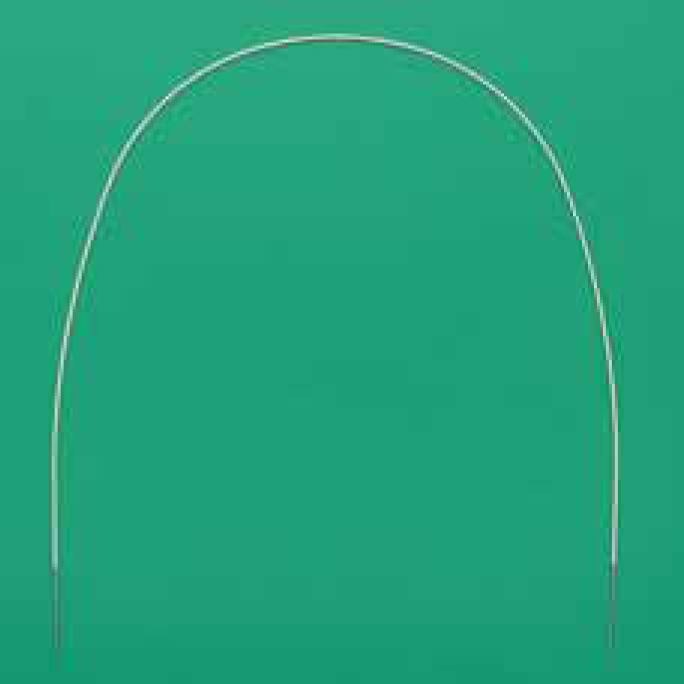
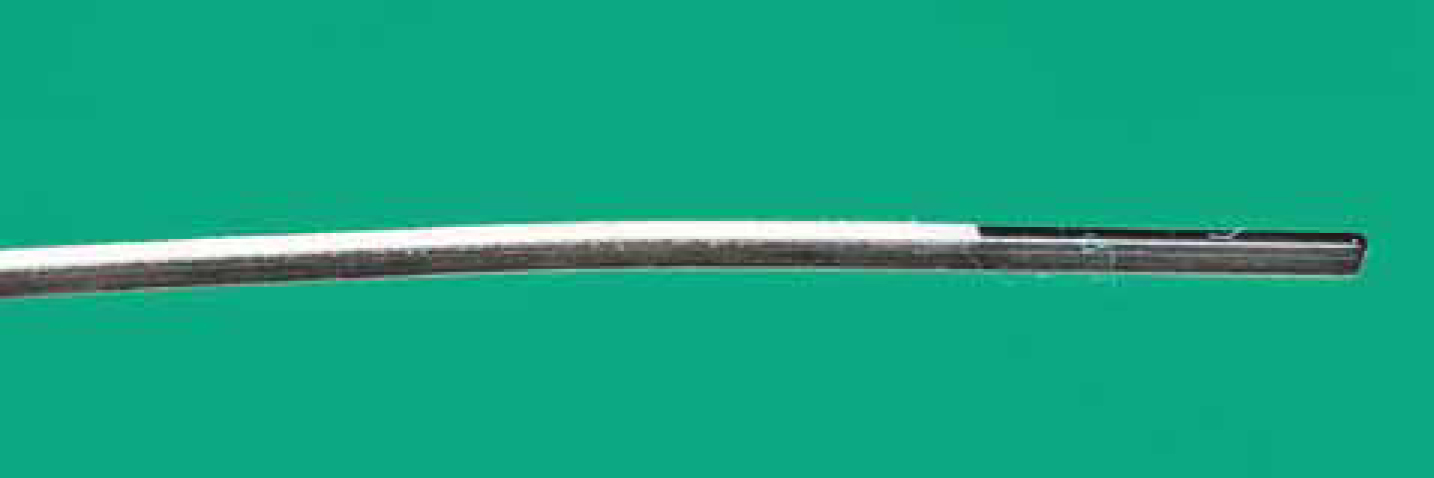
An alternative to these two polymeric coatings is to apply a rhodium coating to the underlying metallic archwire. This produces a surface with low reflectivity, giving a matt white or frosted appearance. Examples of commercially available archwires with a rhodium coating are the Sentalloy® High Aesthetic and Bioforce® High Aesthetic, both of which are coated nickel titanium archwires by GAC International (Bohemia, New York, USA). The same coating is also available on the spring clips of the aesthetic self-ligating In-Ovation C bracket by the same manufacturer.
The non-metallic aesthetic archwires can be subdivided into:
Optiflex® was an early non-metallic aesthetic archwire consisting of three layers, namely an innermost core of silicon dioxide, which provided the force for tooth movement, an intermediate layer of silicon resin, added to provide strength and to protect the core from moisture and an outermost layer made from nylon to improve stain resistance, to add strength and to prevent damage to the underlying core and resin components.6,7 An early in vitro study by Dickson et al5 encouragingly found that Optiflex® demonstrated the lowest static frictional resistance with stainless steel brackets, when compared to stainless steel, super-elastic nickel titanium, co-axial stainless steel and epoxy-coated stainless steel archwires. However, a separate, in vitro comparative study looking at three different archwires undertaken by Lim et al2 found that 0.017″ Optiflex® had a low stiffness, low resilience and a poor springback when compared to a 0.018″TeflonTM coated stainless steel or an 0.017″ uncoated stainless steel archwire. It was therefore concluded that the clinical efficacy was probably limited and, as a consequence, Optiflex® never achieved much in the way of commercial success as an aesthetic archwire.
Polyacetyl was used to create an early prototype polymeric aesthetic archwire. However, this material was found to lack the necessary stiffness and resilience for clinical use and never progressed beyond the laboratory testing phase.8
Watari et al9 undertook an in vitro investigation, testing epoxy and poly(methyl methacrylate) polymeric aesthetic archwires. However, once again both materials lacked the necessary flexural rigidity for use as an orthodontic archwire.
The idea of a fibre-reinforced composite being of use as a possible orthodontic aesthetic archwire began in the late 1980s.10,11 Over the past two decades, several research groups have investigated the production of prototype fibre-reinforced composite aesthetic archwires. They have all explored different types of glass for the fibre component embedded within different resin matrices and have utilized various methods of manufacture.9,12,13,14,15,16,17,18
A novel method of fibre-reinforced composite archwire production was described by Kennedy and Kusy13,14 in which photo-pultrusion was used to produce ultra-violet cured glass-reinforced polymer composites. Zufall et al18 investigated the frictional characteristics of a fibre-reinforced composite archwire made using this photo-pultrusion method. The prototype archwires were made from S2 glass® and a resin comprising 61% bisphenol-A diglycidyl methacrylate (Bis-GMA) and 39% triethylene glycol dimethacrylate (TEGDMA) by weight, and with a 0.020″ round profile. Tests for friction conducted in the dry state, using 0.022″ slot stainless steel, polycrystalline alumina and single crystal alumina brackets, demonstrated that composite archwires had coefficients of friction greater than stainless steel archwires, but less than nickel titanium and β-titanium archwire materials. The flexural properties of photo-pultruded composite archwires in both round (0.022″) and rectangular (0.021″ × 0.028″) cross-section were determined by three point bend testing.16 The investigators concluded that the elastic modulus of their prototype fibre-reinforced composite archwire lay midway between that of martensitic nickel titanium (33.4 GPa) and β-titanium (72.4 GPa). Additionally, the prototype archwire produced about 25% of the force of stainless steel wire per unit of activation. The flexural strength of the fibre-reinforced composite archwire was within the range of published values for β-titanium wires (1.3–1.5 GPa).
Research by Watari et al9 investigated prototype fibre-reinforced polymeric (FRP) wires. These consisted of combinations of two polymers, epoxy and poly(methyl methacrylate), and two types of filler materials, namely long silane-coated alumina fibres and fibres made from calcium oxide, diphosphorus pentoxide, silicon dioxide and aluminium oxide (CPSA glass). Two methods of production were also investigated, namely mould polymerization and hot drawing, and using these techniques round 0.5 mm diameter wires were constructed. It was found that the FRP wires produced using the hot drawing method demonstrated the stiffness and strength needed for orthodontic applications. The epoxy/alumina wire contained small bubbles, making the wire more translucent than transparent. What is somewhat surprising is that this aesthetic wire was reported to have the desirable properties necessary for clinical orthodontics and yet it has never made it to the commercial market. This perhaps once again demonstrates how laboratory findings do not necessarily translate to the clinical environment.
Using a different fibre and resin matrix combination, Huang et al17 created a composite archwire material using unidirectional E-glass with a fibre diameter of 9 mm and a 68:32% by weight epoxy and hardener matrix. Additionally, this study aimed to undertake only in vitro mechanical testing of the prototype archwire in order to determine the effects of the fibre reinforcement pattern upon the mechanical properties. The method of fabrication involved using tube shrinkage, rather than pultrusion, as it is claimed to prevent damage to the glass fibre component, which can arise during pultrusion. Another cited advantage is that tube shrinkage enables the fabrication of rectangular profile wires, which they claim is not possible with pultrusion. Placement of the glass fibres and epoxy resin in the tube is followed by vertical suspension and the application of heat via a soldering iron. This results in its contraction and the subsequent expulsion of any excess resin inferiorly. The resultant material is placed into an archwire-shaped mould and then heated in an oven at 100°C to complete the curing process. In this way, a 0.5 mm (0.020″) diameter prototype archwire was created with a 45% volume fraction of fibre. This archwire was designed to be used in the initial alignment phase of orthodontic treatment. The bending modulus was found to be 31.8 GPa, compared to 38.9 GPa for a 0.406 mm (0.016″) nickel titanium wire. The authors felt this prototype archwire was less flexible and more brittle than equivalent metal orthodontic archwires, which would pose a problem in aligning severely malposed teeth. It was suggested that ductility could be improved by the use of nanofibres, as these possess higher stiffness and strength, but are more ductile than micron diameter fibres. Further research by this group investigated the preliminary mechanical design of a composite archwire, by investigating changes in fibre volume fraction, whilst keeping the diameter of the wire constant, and vice versa. They believe that the desired mechanical properties of the archwire can be achieved at the design stage by changing the constituent materials, their ratios and the dimensions of the wire.
At present, there is only one commercially available fibre-reinforced polymer composite aesthetic archwire. This is produced and manufactured by BioMers Pte Ltd (Singapore) (Table 2). It is made of a continuous fibreglass filament in a polymer resin composed of ethylene Bisphenol-A-Dimethacrylate, triethyleneglcol dimethacyrlate, glass frit and surrounded by a Di-p-Xylylene polymer coating. The constituent materials are inserted into a shrinkable die in the shape of an archform. The purported advantages of this technique is that it allows the uniform distribution of constituent materials throughout the wire, producing a wire with uniform cross-section and hence there is no need for secondary post processing to produce an archform. The wire is only available in round cross-section and for the levelling and alignment phase of treatment. At present a rectangular profile wire is not available for use during the intermediate and final stages of treatment, however, this is being developed.
| Archwire | Manufacturer/Distributor | Archwire material | Available dimensions |
|---|---|---|---|
| Transluscent Archwire/OPTISTM | BioMers Products www.biomersbraces.com | Fibre-reinforced polymer composite | Available in round profile 0.014″, 0.016″ and 0.018″ |
The manufacturers state that this wire is susceptible to fracture during treatment and should not be deflected beyond an angle greater than 60°. Whitening of the surface of the archwire is said to indicate crazing and is a sign that the wire could fracture in that location. Owing to the preformed nature of the wire, it cannot be reshaped and so artistic bends or stops cannot be placed. Any attempt to undertake this is likely to result in fracture of the wire. The manufacturers also suggest that the wire is supported with bumper tubing or metal coil over large spans, as masticatory function might also lead to fracture. The use of such supporting materials, particularly anteriorly, is likely to make the appliance more noticeable and less aesthetic. Interestingly, instructions on the use of the wire are supplied for both the clinician and the patient.
Orthodontic brackets have been constantly evolving in response to market pressures for more consistent production values, improved durability, less friction, better bonding and improved convenience. As time has progressed the demand for a more aesthetic alternative has emerged. To some extent this was aided by the introduction of direct bonding to enamel, that became common practice in the 1970s following work carried out by Newman.19 This enabled the orthodontist to bond to the enamel surface reliably without the need for a band around the tooth. Whilst this was an improvement in terms of aesthetics, there was still a significant amount of metal visible on the buccal surface of the teeth. The first truly aesthetic brackets appeared in 1963 and were injection moulded from polycarbonate, and bonded to the teeth using an unfilled polymethacrylate resin.20 Whilst these brackets initially showed promise in terms of improved aesthetics, there were significant failings in their clinical performance and they suffered from a high failure rate. Consequently, the development and introduction of aesthetic brackets stagnated somewhat until 1987 with the introduction of ceramic brackets.21
Ceramic brackets can be classified into monocrystalline, polycrystalline and zirconia (Table 3).
| Material | Bracket | Manufacturer/ Distributor | |
|---|---|---|---|
| Ceramic | Monocrystalline | SPA | DB Orthodontics |
| Inspire ICE | Ormco |
||
| Radiance | American Orthodontics |
||
| Pure | Ortho Technology |
||
| Allure | GAC International |
||
| Purity | Orthocare |
||
| Polycrystalline | Avex CXi | Opal Orthodontics |
|
| Clarity/Clarity SL | 3M Unitek |
||
| Integra | Ortho Byte |
||
| Contour | DB Orthodontics |
||
| Aspire | Forestadent |
||
| Virage | American Orthodontics |
||
| Mystique MB | GAC International |
||
| Reflection | Ortho Technology |
||
| Vision | Hawley Russell |
||
| InVu | TP Ortho |
||
| Plastic | Polyurethane | Synthesis | Ortho Byte |
| Avalon | DB Orthodontics |
||
| Polar | Ortho care |
||
| Polyoxymethylene | Brilliant | Forestadent |
|
| Polycarbonate | Silkon Plus | American Orthodontics |
|
| Elegance | Dentarum |
Monocrystalline brackets are manufactured by heating aluminium oxide to temperatures in excess of 2100°C. The molten mass is cooled slowly, and the bracket is machined from the resulting crystal, creating a completely transparent, highly aesthetic bracket (Figures 3 and 4). Polycrystalline brackets are less complicated to produce and therefore more brands are available on the market (Figure 5). They are manufactured by blending aluminium oxide particles with a binder and the resultant mixture can be formed into a shape from which a bracket can be machined. The sintering process is conducted with temperatures above 1800°C in order to burn out the binder and fuse together the particles of the moulded mixture. The bracket can then be heat treated in order to remove surface imperfections. This process has been further refined by injection moulding of the aluminium oxide to create the final desired bracket shape, thereby reducing the amount of milling that is normally required to provide the final bracket shape. This reduces the likelihood of generating surface imperfections which can otherwise lead to in-service bracket failures. Even small surface imperfections have been shown to have a significant impact by reducing the load to fracture of ceramics.22 As the name suggests, polycrystalline brackets are composed of very many fused crystals rather than a single crystal, as is the case with monocrystalline brackets. As the individual crystal sizes increase so do the optical properties of the material. However, this is usually to the detriment of material strength. Therefore, while monocrystalline brackets are perhaps more aesthetic, they are less durable than polycrystalline brackets.
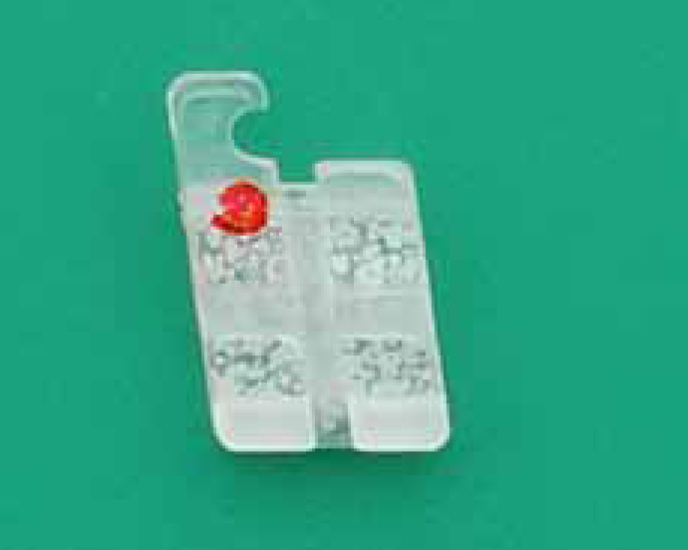
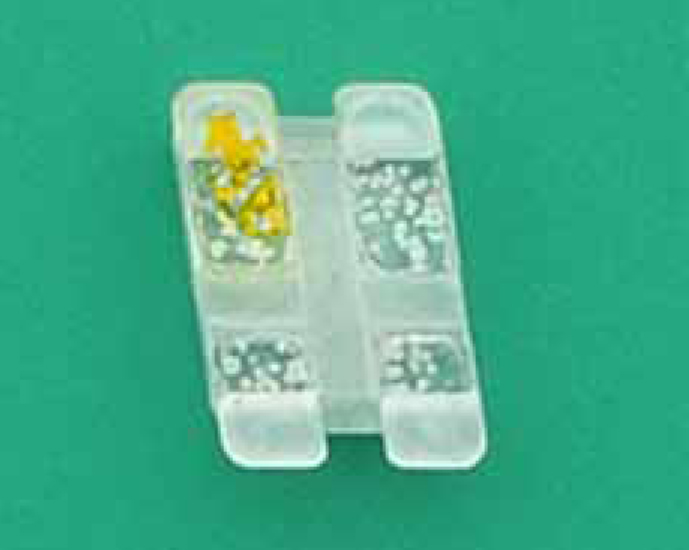
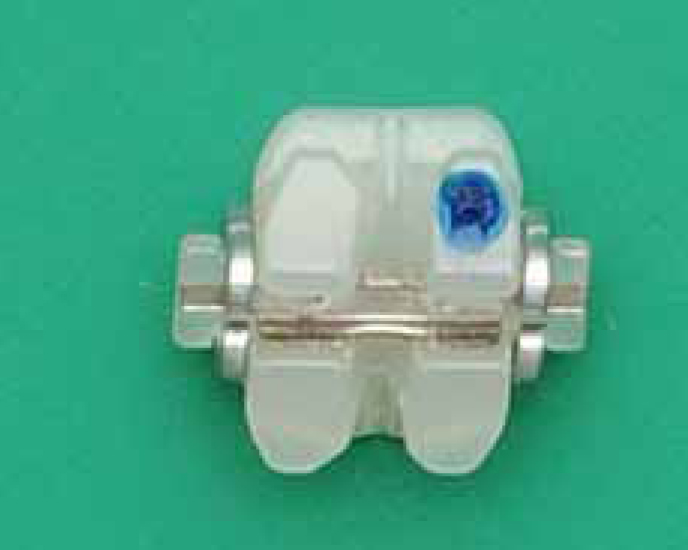
Zirconia brackets have the greatest toughness among all ceramics and the potential advantage as an orthodontic bracket would be fewer in-service failures, for example fractured tie-wings. In addition, the surface of this ceramic is relatively smooth and it was initially thought that this would reduce the friction encountered when in contact with metallic archwires. However, zirconia never became established as an orthodontic bracket material owing to the opaque appearance of the resulting bracket and the fact that it has no significant advantage over polycrystalline brackets in laboratory tests.23
All ceramics are significantly harder than stainless steel, however, they are also harder than tooth tissue and this can result in problems with abrasion of enamel and dentine on occlusion. It can be a particular problem with upper incisor teeth if ceramic brackets have been placed on lower incisors where there is an increased and complete overbite, during space closure and during overjet reduction, as upper canines are brought into occlusion with lower ceramic brackets. This has previously been reported as the most common form of injury following ceramic bracket use.24
As previously described, ceramic brackets have a low fracture toughness and, in particular, a low tensile strength. The toughness of ceramic brackets is commonly between 20–40 times less than stainless steel25 and so they have a tendency to fracture both during treatment, for example tie-wing fracture, and at debond.26 With improvements in bracket design and manufacturing control, the strength of ceramic brackets has improved, reducing the risk of mid treatment fracture, but this may present additional problems at debond.
Ceramics cannot chemically bond to diacrylate-based adhesive resins owing to their inert composition and so, to overcome this problem, manufacturers introduced glasses to the bracket base which were coated with a silane coupling agent to act as a mediator between the bonding resin and bracket base.27 The resultant bond strengths were extremely high and were associated with an increased risk of enamel fracture at debond.28
In an attempt to mitigate this risk, manufacturers have instead used slots and grooves on the bracket base to promote mechanical adhesion between the bracket base and bonding resin. This has been shown to produce more predictable bond failure either within the adhesive layer or at the adhesive/bracket base interface.29 Other methods used to reduce the risk of enamel fracture include the incorporation of a polymeric bonding base on the ceramic bracket, for example CeramaFlex and latterly MXi brackets by TP Orthodontics (La Porta, Indiana, USA). At debond the polymeric base separates from the ceramic, thereby reducing the risk of enamel failure as the polymeric base and bonding adhesive are easily removed using a debonding bur. Indeed, the force required to debond such brackets is reduced to a level which is similar to that produced between the adhesive and a conventional stainless steel bracket base.30 One of the problems with the original CeramaFlex brackets was that the bond strength was reduced so much that the brackets would debond during treatment. An alternative approach to reduce the risk of enamel fracture at debond is the introduction of a vertical notch in the centre of the bracket which acts as a stress concentrator, as may be seen with 3M Clarity® bracket (3M Unitek, Monrovia, California, USA). Preferential bond failure will arise at this stress raising notch, when appropriate forces are applied at debond, rather than at the enamel surface and so the risk of enamel failure is considerably reduced. Indeed, much of the adhesive remains on the enamel, further reducing the risk of enamel, damage.31
A number of authors have examined the various options for removal of ceramic brackets and it was concluded by Schwartz32 that debonding pliers that result in tensile bond failure within the bracket/adhesive interface provided the safest and most effective method of reducing the risk of enamel fracture.
Initially marketed in the 1970s, early problems identified with plastic brackets included staining, lack of strength and stiffness, tie-wing fracture and permanent deformation. Significant water absorption also resulted in discoloration of the bracket.33 Fracture of these early plastic brackets was thought to be related to this increased water absorption.34
Thermoplastic resins, such as polycarbonate used in the fabrication of plastic brackets, are particularly prone to deformation under load. This can either occur immediately, due to the inherent elasticity of the material, or it can happen over time and is known as creep. Such deformation is particularly relevant when torquing forces are applied. Full expression of torque relies on full engagement and interaction of the internal aspect of the bracket slot with the archwire. Any change in the internal dimensions of the bracket slot as a result of deformation, either immediate or delayed, therefore has a huge impact on the expression of torque.
In order to try to reduce the degree of deformation and also to improve other properties, fillers are now added to plastic brackets. Generally, fillers improve stiffness, produce a material with higher elastic limits, improved fracture resistance and better wear characteristics.35 A range of filler particles are commonly used, including silicon dioxide, aluminium dioxide, barium, zirconium oxide, borosilicate and barium aluminium silicate glasses. Bonding of the filler to the resin matrix is achieved by coating the filler particles with a silane coupling agent, such as methacryloxypropyl trimethoxysilane. These bonds degrade when exposed to water, as might occur intra-orally, and as a result such particles might be lost from the bracket surface with time.36
The clinical performance of reinforced brackets, when compared to unreinforced brackets, has been examined by a number of authors, including Feldner et al,37 who concluded that polycarbonate brackets that had been reinforced with glass filler particles had clinically more acceptable torque values than unreinforced brackets and showed markedly less deformation.
Another method of decreasing the deformation of the bracket slot is the inclusion of a metal slot liner (Figure 6).
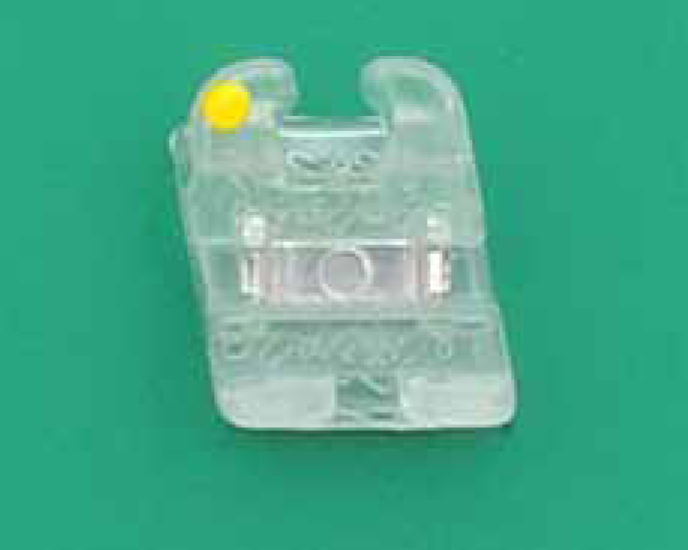
Work carried out by Harzer et al38 compared a conventional stainless steel bracket with a plastic bracket with and without a reinforcing metal slot liner. They reported significantly higher torque losses with the plastic brackets when compared to the metal bracket and, although the metal liner reduced these effects, it did not act to reduce torque loss to the extent anticipated. An interesting study by Sadat-Khonsari et al39 investigated the effect torque had on permanent deformation of a range of plastic/composite brackets following simulated clinical ageing. The brackets were heat cycled and stored in water to simulate the ageing process. Despite the addition of glass fibre or ceramic filler particles, the deformation of the brackets under torquing forces was not significantly different from unfilled polycarbonate brackets. Instead, it was found that a metal liner was necessary to resist the forces generated during torquing. The results showed a significantly higher degree of deformation than previously found and highlighted the environmental effect of the structural integrity of these brackets. It must also be remembered that the majority of investigations into torque loss from plastic brackets involve immediate testing of the initial viscoelastic response to an applied force. The issue of creep over a prolonged period of time is of as much clinical importance as the initial deformation.
As with ceramic brackets, the frictional characteristics of plastic brackets has been investigated. Surprisingly, it has been found that composite brackets demonstrate lower frictional forces compared to both the stainless steel bracket and ceramic brackets, regardless of the wire size used or the method of ligation. It was also found that the presence of a metal slot liner had no discernible effect on the friction generated.40
The use of filler particles, metal liners and improved production techniques have steadily improved the performance of plastic bracket systems to the point that they are now a viable alternative to either stainless steel or ceramic brackets. Certainly, when compared to ceramic brackets, the reduced risk of enamel wear, reduced archwire friction (experimentally at least) and the reduced risk of enamel damage at debond suggest that there is considerable potential in the more modern plastic brackets. Issues regarding expression of torque and resistance to creep still require further work but, undoubtedly, with the development of better materials these problems can be reduced and hopefully eliminated.
The quest for improved performance often leads to new materials being used and, in 1997, a new plastic bracket composed of polyoxymethylene (POM) was released. This bracket had significantly improved resistance to fracture compared to polycarbonate brackets and improved colour stability with reduced staining. One of the major problems with POM is that it can depolymerize under certain conditions, such as thermal, chemical or mechanical challenge, and produce formaldehyde. Formaldehyde has the potential to cause allergic skin reactions, nervous system depression, liver and kidney damage. Depolymerization of these brackets has been shown to occur under thermal challenge and, given the potential severity of side-effects, the authors felt that the use of POM is contra-indicated in orthodontic and paedodontic materials.41
The superior aesthetics of both plastic and ceramic brackets are a significant advantage over conventional stainless steel brackets. However, the concerns over clinical performance still exist. Significant developments in product design have vastly improved the performance of aesthetic brackets; modifications to manufacturing processes, slot design and base design have in some way addressed the major flaws of the early brackets. Further developments are required to ensure that the standards of clinical performance demanded from conventional brackets are carried over to aesthetic brackets.
In recent years a number of self-ligating ceramic brackets have been introduced. The advantage of such brackets is that there is no need to use elastomeric ‘O’ rings which can discolour with time. However, they still require the use of elastomeric chains for space closure which can discolour. Difficulties in manufacturing self-ligating brackets with aesthetic moving clip or slide mechanisms mean the choice at present is limited. The Oyster bracket (GAC, Bohemia, NY, USA) and the new Damon Clear brackets (Ormco, Glendora, CA, USA) are the only ones that can be considered as truly aesthetic brackets. The Oyster bracket is manufactured from reinforced polycarbonate, whilst the Damon Clear bracket consists of a polycrystalline ceramic bracket with a polycrystalline sliding clip mechanism. Other alternatives include In-Ovation C (GAC, Bohemia, NY, USA), which consists of a polycrystalline ceramic with a rhodium-plated metal clip which has a frosted white appearance. The Clarity SL bracket (3M Unitek, Monrovia, California, USA) is also a polycrystalline ceramic bracket which combines the Clarity bracket with the Smartclip ligation system, and so has minimal metal showing on the labial surface.
Both epoxy and TeflonTM coated short (Figure 7 and 8) and long ligatures are currently available for clinical use and from a number of different suppliers (Table 4). Laboratory studies have demonstrated that TeflonTM coated stainless steel ligatures produce less friction than other methods of ligation.42,43 Like the coated archwires, the coating tends to come off, exposing the underlying metal ligature. Although coated ligatures offer enhanced aesthetics, they should be used cautiously with ceramic brackets. If such a ligature should scratch the surface of a tie-wing during placement or removal, it will increase the chance of fracture of the bracket during service.

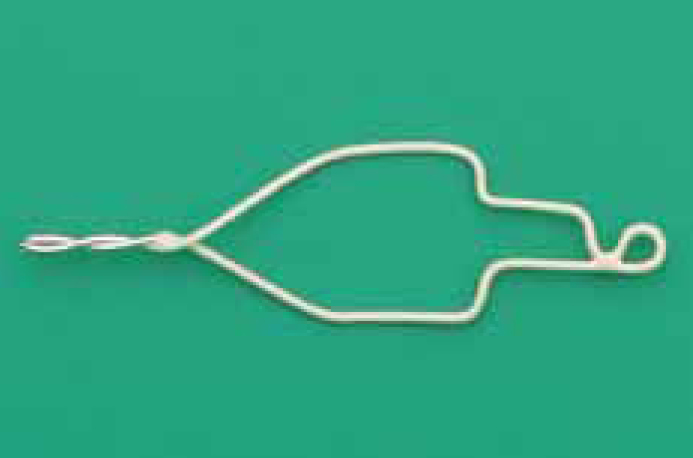
| Accessory | Product | Manufacturer/Distributor |
|---|---|---|
| Tooth-coloured coated preformed long ligature ties | Confidential TM ligature ties | ClassOne Orthodontics |
| Preformed ligature ties | Ortho Technology |
|
| Preformed ligature ties | Forestadent |
|
| Pearl-tone preformed wire ligatures | Precision Orthodontics |
|
| Pre-formed coated ligatures | DB Orthodontics |
|
| Pre-formed ligature wire | 3M Unitek |
|
| Tooth-coloured coated preformed short ligature ties | Preformed Shorty Ties Coated Kobayashi Shorty Ties | Ortho Technology |
| Preformed Kobayashi Ligature Ties | Forestadent |
|
| Pre-cut Short Coated Ligatures | DB Orthodontics |
|
| Tooth-coloured NiTi open coil spring | NiTi Open Coil Spring | Ortho Technology |
| Tooth-coloured crimpable hooks | Tooth Tone Aesthetic Coated Crimpable Ball Hooks | Ortho Technology |
An alternative to the coated ligatures are transparent polyurethane elastomerics. However, these suffer from two disadvantages, namely; they tend to discolour rapidly in the oral cavity due to absorption of food stuffs, such as turmeric, making them visible and hence negating any aesthetic advantage. Secondly, when used with ceramic brackets, it is difficult to tie a figure of eight owing to the increased size of the bracket tie-wings compared to metallic brackets.
In addition, coated Crimpable Ball Hooks (Figure 9) and NiTi Open Coil Spring (Figure 10) with Tooth ToneTM (Ortho Technology, Tampa, Florida, USA) are available to make the fixed appliance less conspicuous.


In conclusion, it can be seen that developments in aesthetic archwires, brackets and accessories have led to the availability of many products which can produce a clinically reliable labial fixed appliance for use in patients who would not otherwise undergo orthodontic treatment with conventional metallic fixed appliances. However, there is still scope for further improvements.